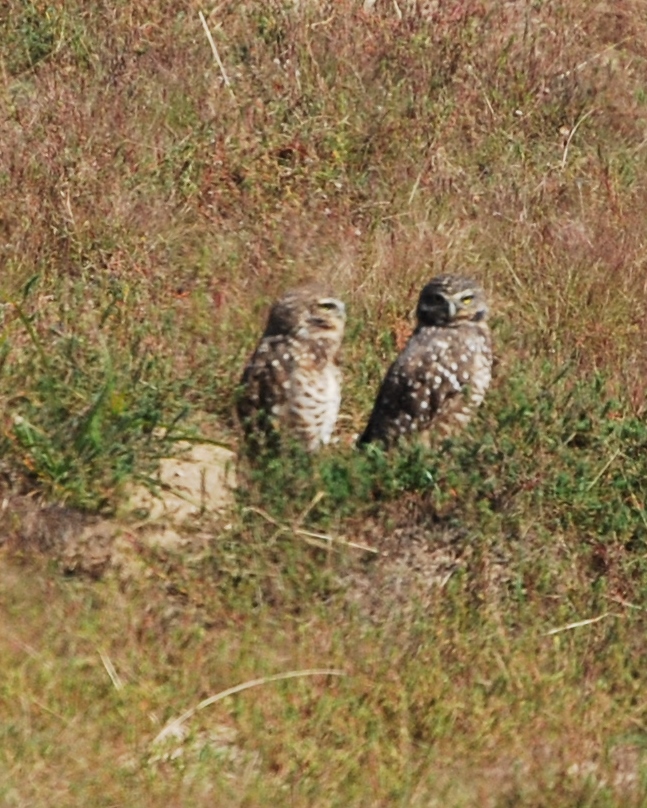
As you can tell from recent columns, I love birds of prey, especially owls. Among my top ten favorite life experiences has been sitting on my brothers porch after dark, buried deep in the southeastern Ohio woods, listening to the sounds of the night.
There are whippoorwills and coyotes and all the small croaking, twittering creatures of the dark, but the main attraction is always the owls. From the eerie whines of tiny screech owls, to the deep, bass moans of great horned owls, and the tell-tale “Who cooks for you, who cooks for you too” cries of barred owls, the night time woods comes alive with owl calls.
A little known owl species here in Kansas is the burrowing owl, a medium sized owl without a unique, memorable sound, that make their home in abandoned badger and prairie dog dens. I was introduced to burrowing owls a few years back during an opening day pheasant hunt near my home. We were a large group of 15 or so hunters and were trudging across an overgrown CRP field. As we walked, birds identified by the landowner (who was with us) as hawks began taking flight, one-at-a-time from out of nowhere.

Looking back, I believe those birds were in fact burrowing owls being spooked by our presence from their dens that were probably old abandoned badger holes.
Studies show burrowing owl populations to be in sharp decline, easily imagined here in Midwestern farm country where badger dens are not welcome and are filled-in when possible, and where prairie dogs towns as a whole are hard to come by anymore. They are listed as endangered in Canada, as threatened in Mexico and as endangered, threatened or of special concern in 9 of the United States.
Here in Kansas they are listed as “vulnerable.” Burrowing owls are active both day and night and often live in colonies of several mated pairs. They drag all manner of stuff into their dens as nesting material, and I found numerous mentions of cow manure being a favorite. Researchers believe the manure somehow helps control the microclimate of the den, plus attracts insects which the owls feed on.
Typical clutch sizes are from 3 to 12 eggs, and large families of chicks are often raised.
Their main diet is mice and moles during spring and early summer when they’re still feeding hungry chicks, then mainly grasshoppers and beetles as long as they can still be found. Burrowing owls stand 10 to 12 inches tall when mature and have long, featherless legs and white eyebrows above extremely large, bright and beautiful yellow eyes.
All birds make some sort of vocal sounds, and even though burrowing owl calls are not noteworthy at all compared to some of their vocal cousins, they do make a few cooing, chirping sounds, the most recognized being a 2-note sound reminiscent of a quail call.
We recently watched a TV documentary about swift foxes and burrowing owls living in suburban neighborhoods around Las Vegas. Since watching that documentary, we have found a couple dens of burrowing owls living in a sprawling prairie dog encampment near Walmart in Hutchinson. We can see their dens from a side street, so now every time we are in that part of town (which is way too often for me) we swing past, and if they are sitting at the entrance to their den, we stop and watch awhile. They are surrounded by active prairie dog dens and the dogs scurry about and graze as if the owls weren’t there at all.
In fact, the little owls probably benefit from the prairie dogs surveillance system. In an active prairie dog town there are always certain occupants designated as sentries whose job it is to keep watch for danger, and when intruders are spotted in the form of foxes, hawks or merely nosey humans, they sound an alarm by rising quickly up on their hind feet, stretching their heads skyward and emitting shrill high pitched chirps of danger, sending all their brethren scurrying for cover and affording the owls a chance to dive into their burrows too.
One of these days I’m going to wonder around through the prairie dog towns around Walmart to see if there are signs of any other little owls there. I’ve always wondered if there are prairie rattlesnakes living there amongst the prairie dogs too. They are common inhabitants of abandoned prairie dog dens, although not quite as cordial as the owls, given that they eat the landlords…. Continue to Explore Kansas Outdoors!
Steve Gilliland, Inman, can be contacted by email at [email protected].
